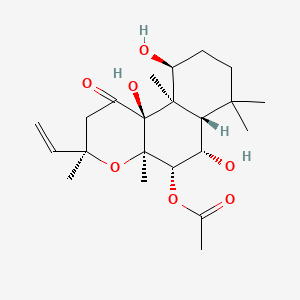| Li H et al. |
Differential regulation of MAP kinase activity by corticotropin-releasing hormone in normal and neoplastic corticotropes. |
1998 |
Int. J. Biochem. Cell Biol. |
pmid:9924808
|
| Tu TY et al. |
cAMP mediates transepithelial K+ and Na+ transport in a strial marginal cell line. |
1999 |
Hear. Res. |
pmid:9925027
|
| Fleming JV et al. |
Ovine arylalkylamine N-acetyltransferase in the pineal and pituitary glands: differences in function and regulation. |
1999 |
Endocrinology |
pmid:9927331
|
| Gerhardt CC et al. |
Stimulation of the extracellular signal-regulated kinase 1/2 pathway by human beta-3 adrenergic receptor: new pharmacological profile and mechanism of activation. |
1999 |
Mol. Pharmacol. |
pmid:9927616
|
| McDonald TP et al. |
Desensitization of the human vasoactive intestinal peptide receptor (hVIP2/PACAP R): evidence for agonist-induced receptor phosphorylation and internalization. |
1998 |
Ann. N. Y. Acad. Sci. |
pmid:9927998
|
| Ekblad E et al. |
Relaxant responses of VIP and PACAP in rat ileum: receptors and adaptive supersensitivity. |
1998 |
Ann. N. Y. Acad. Sci. |
pmid:9928037
|
| Shioda S et al. |
PACAP increases cytosolic calcium in vasopressin neurons: synergism with noradrenaline. |
1998 |
Ann. N. Y. Acad. Sci. |
pmid:9928043
|
| Yildiz O et al. |
Characterization of the "silent" 5-HT1B receptors of rabbit iliac artery. |
1998 |
Ann. N. Y. Acad. Sci. |
pmid:9928277
|
| Mørk A |
Effects of lithium treatment on extracellular serotonin levels in the dorsal hippocampus and wet-dog shakes in the rat. |
1998 |
Eur Neuropsychopharmacol |
pmid:9928915
|
| Grinkevich LN et al. |
[The activation of the transcription factors of the CRE and AP-1 families correlates with the development of plasticity in Helix]. |
1998 Nov-Dec |
Zh Vyssh Nerv Deiat Im I P Pavlova |
pmid:9929912
|
| Ohkura N et al. |
An isoform of Nurr1 functions as a negative inhibitor of the NGFI-B family signaling. |
1999 |
Biochim. Biophys. Acta |
pmid:9931442
|
| Marambaud P et al. |
Post-transcriptional contribution of a cAMP-dependent pathway to the formation of alpha- and beta/gamma-secretases-derived products of beta APP maturation in human cells expressing wild-type and Swedish mutated beta APP. |
1998 |
Mol. Med. |
pmid:9932109
|
| Gomes FC et al. |
Cerebellar astrocytes treated by thyroid hormone modulate neuronal proliferation. |
1999 |
Glia |
pmid:9932871
|
| Florio C et al. |
Involvement of P1 receptors in the effect of forskolin on cyclic AMP accumulation and export in PC12 cells. |
1999 |
Biochem. Pharmacol. |
pmid:9933023
|
| Arslan G et al. |
Signaling via A2A adenosine receptor in four PC12 cell clones. |
1999 |
Naunyn Schmiedebergs Arch. Pharmacol. |
pmid:9933147
|
| Maltsev VA et al. |
Establishment of beta-adrenergic modulation of L-type Ca2+ current in the early stages of cardiomyocyte development. |
1999 |
Circ. Res. |
pmid:9933244
|
| Feng WG and Chang ZL |
Expression of cytokine mRNA during immuno-modulation of murine suppressor macrophages. |
1998 |
Cell Res. |
pmid:9934540
|
| Glushakov AV et al. |
Modulation of nicotinic acetylcholine receptor activity in submucous neurons by intracellular messengers. |
1999 |
J. Auton. Nerv. Syst. |
pmid:9935265
|
| Lin L et al. |
Expression of endogenous retrovirus ERV-3 induces differentiation in BeWo, a choriocarcinoma model of human placental trophoblast. |
1999 |
Placenta |
pmid:9950152
|
| Liu W et al. |
beta-adrenergic modulation of L-type Ca2+-channel currents in early-stage embryonic mouse heart. |
1999 |
Am. J. Physiol. |
pmid:9950862
|
| Nishimoto G et al. |
Arginine vasopressin stimulates phosphorylation of aquaporin-2 in rat renal tissue. |
1999 |
Am. J. Physiol. |
pmid:9950956
|
| Brophy CM et al. |
The small heat shock-related protein-20 is an actin-associated protein. |
1999 |
J. Vasc. Surg. |
pmid:9950990
|
| Watts VJ et al. |
Short- and long-term heterologous sensitization of adenylate cyclase by D4 dopamine receptors. |
1999 |
Psychopharmacology (Berl.) |
pmid:9952069
|
| Washizuka T et al. |
Genistein inhibits slow component delayed-rectifier K currents via a tyrosine kinase-independent pathway. |
1998 |
J. Mol. Cell. Cardiol. |
pmid:9990530
|
